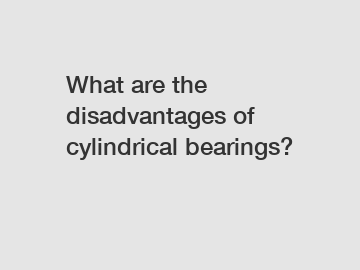What are the disadvantages of cylindrical bearings?
What are the disadvantages of cylindrical bearings?
Cylindrical bearings are widely used in various industries due to their versatility and excellent load-carrying capabilities. However, like any other mechanical component, these bearings have their own set of disadvantages that can impact their performance and durability. In this article, we will delve into the drawbacks of cylindrical bearings in order to provide a comprehensive understanding of their limitations.
1. Limited misalignment compensation:

Cylindrical bearings are designed to handle radial loads and provide high stiffness. However, they have limited ability to compensate for misalignment. Misalignment occurs when the bearing's inner and outer rings are not perfectly aligned. This can result in increased friction, premature wear, and reduced bearing life. Therefore, in applications where misalignment is a common occurrence, alternative bearing types, such as spherical roller bearings, may be more suitable.
2. High heat generation:
Cylindrical bearings, particularly when operating under heavy loads or high speeds, can generate significant heat. Heat generated from the bearing's operating conditions not only affects the bearing itself but can also impact the surrounding components. Excessive heat can lead to thermal expansion, which can cause interference with neighboring parts, leading to failure and reduced performance. Moreover, increased temperatures can accelerate lubricant breakdown, reducing its effectiveness in providing adequate lubrication and potentially causing bearing failure.
3. Limited axial load capacity:
Unlike thrust bearings that are specifically designed to handle axial loads, cylindrical bearings have a relatively limited capacity to support such loads. Axial loads, which act parallel to the shaft axis, can cause excessive stress and deformation in cylindrical bearings, leading to reduced bearing life and premature failure. In applications where significant axial loads are expected, other bearing types, such as thrust bearings or angular contact bearings, should be chosen to ensure optimal performance and longevity.
4. Vulnerability to contamination:
Cylindrical bearings are susceptible to contamination from dust, dirt, and other particles present in the operating environment. Contaminants can enter the bearing through various sources, including improper sealing, inadequate maintenance, or operation in harsh conditions. Once inside the bearing, these particles can create abrasive wear, leading to increased friction, heat generation, and ultimately, bearing failure. Regular cleaning, proper sealing, and the use of protective devices such as shaft seals can help mitigate this issue.
In conclusion, while cylindrical bearings offer numerous advantages in terms of load-carrying capacity and versatility, they also come with their fair share of disadvantages. Their limited ability to compensate for misalignment, high heat generation, limited axial load capacity, and vulnerability to contamination need to be carefully considered when selecting bearings for specific applications. By understanding these drawbacks, engineers can make informed decisions and opt for alternative bearing solutions, if necessary, to ensure optimal performance and reliability in their equipment.
If you want to learn more, please visit our website tappered roller bearings wholesale, agricultural machinery bearing, electric motor bearings wholesale.
270
0
0

Comments
All Comments (0)